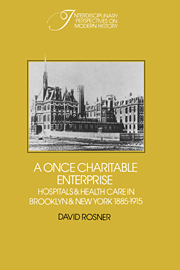Book contents
- Frontmatter
- Contents
- Preface
- Introduction
- 1 Health care and community change
- 2 Embattled benefactors: the crisis in hospital financing
- 3 Social class and hospital care
- 4 Conflict in the new hospital
- 5 Taking control: political reform and hospital governance
- 6 Consolidating control over the small dispensary: the doctors, the city, and the state
- 7 The battle for Morningside Heights: power and politics in the boardroom of New York Hospital
- 8 Looking backward
- Notes on sources
- Notes
- Select bibliography
- Index
3 - Social class and hospital care
Published online by Cambridge University Press: 07 October 2009
- Frontmatter
- Contents
- Preface
- Introduction
- 1 Health care and community change
- 2 Embattled benefactors: the crisis in hospital financing
- 3 Social class and hospital care
- 4 Conflict in the new hospital
- 5 Taking control: political reform and hospital governance
- 6 Consolidating control over the small dispensary: the doctors, the city, and the state
- 7 The battle for Morningside Heights: power and politics in the boardroom of New York Hospital
- 8 Looking backward
- Notes on sources
- Notes
- Select bibliography
- Index
Summary
Because hospital trustees could no longer depend primarily on private benefactors to support their institutions and were instead forced to begin charging patients significant sums, it became necessary to organize and present the hospital to the public in a new way. If patients were to be encouraged to pay for services, the hospitals would have to offer them something different from the services provided at minimal or no charge to the indigent. Some trustees and hospital spokesmen began to organize distinct services for different classes of the population – sometimes separate services within a single institution, and sometimes entirely separate institutions for those who could pay and those in need of charity care.
Once separate private services were introduced, it became necessary to convince the merchants, white-collar workers, and skilled craftsmen who might be expected to use them that hospital care was superior to the treatment they had traditionally received at home, sometimes with the aid of private physicians and private-duty nurses. Accordingly, hospitals began to offer amenities like private and semiprivate rooms, private nurses, better food, and pleasant accommodations for those patients willing to pay the price. But more was necessary to attract to the hospital people who had long received private medical care in their homes. Hospital representatives began to advertise their improved services and also to encourage public newspaper reports from patients convinced of the superiority of hospital care. Often these reports portrayed the hospital as nothing more than a “hotel for rich invalids”.
- Type
- Chapter
- Information
- A Once Charitable EnterpriseHospitals and Health Care in Brooklyn and New York 1885–1915, pp. 62 - 93Publisher: Cambridge University PressPrint publication year: 1982



